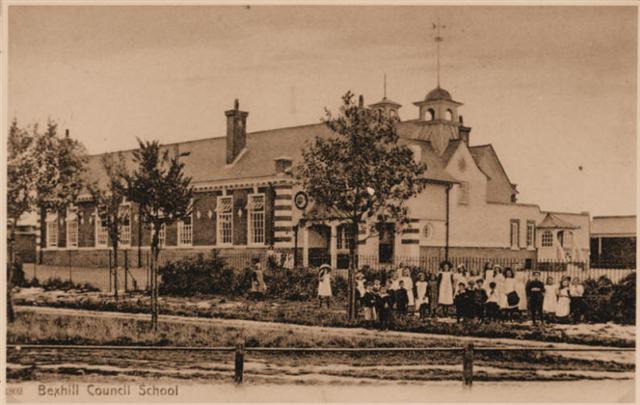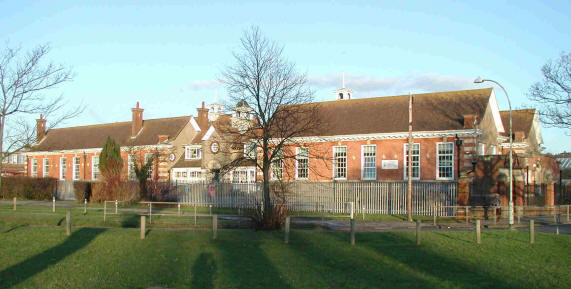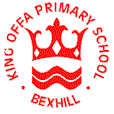
|
The School 1907-1948 |
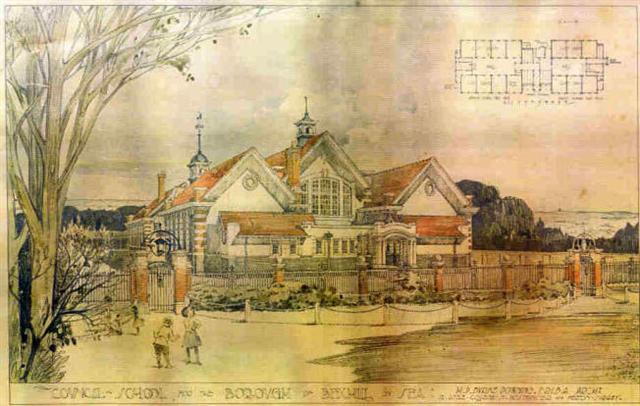
The architects drawing of
how the new school would look.
See also We Are 100 ~ The School 1950-1997 ~ The School Today ~ Photo Gallery ~ Memories
Early History (See also Edwardian Bexhill)
The school celebrated
its centenary on March 7th 2007. The children dressed in Edwardian costume for the day; a "tea party" was held for the
children, with a table running the entire length of both halls, plus tables on
either side of the halls. We had a birthday cake with 100 candles and after
tea we released 100 balloons kindly supplied by the Bexhill Observer.
We
are still looking for old photographs and memories of the school, if you have any that
you can share with us please contact the school on 01424 211548 or by e-mail king(at)kingoffa(dot)e-sussex(dot)sch(dot)uk
"A Children's palace..." the Bexhill Observer's comment on the opening of the school in 1907, click HERE
Prior to 1907 all schools in Bexhill were "Church" schools, in 1903, as a result of the 1902 Education Act, Bexhill formed an Education Committee responsible for Elementary Education in the town. This committee's first task was the building of a school independent from the influence of the Church.
The new "Down Council" school was built on
the site of the old Bexhill Workhouse (known as Workhouse Field) and close to
the first drill hall, built in 1901. The school cost a total of £7718 plus £1000 for the land.
Many local people thought this was much too expensive for a school.
The first part was opened in March 1907, originally for 200 Junior Girls and 200
Mixed Infants, all in the same building! in fact, on opening, there were 160
children in total. Boys were admitted into the Junior section in 1908, but in
separate classes, mixed classes were started later as the school got bigger.
The classrooms were designed to hold 50 children, but there was no furniture
other than desks in rows; neither were there any "displays" as found in
classrooms today.
Two classrooms, the "Baby's Room" (Rm 4) and one other (Rm 1) had fireplaces, the
remainder were heated by hot air from boilers in the cellar.
The first headteacher was Miss Lucy Brizley, with a staff of four other teachers, one trained and one untrained teacher for the Junior Girls section and one trained and one untrained teacher for the Infants section.
|
|
|
Above, as it was then, the original 1907 building. Below, as it is now, the later 1912 building is to the right of the tree in the centre. |
|
|
School records show that the number of children attending school during the early 1900s
was often affected by bad weather and sickness; 'flu, measles and
mumps, heavy rain or snow meant a large number of children would be
absent. September also recorded high absence figures due to children
away hop-picking.
February 1911 saw the school being closed for two weeks due to an outbreak of
mumps, on re-opening a doctor visited the school and closed it again for a
further two weeks as some children were still infected. Other frequent entries
in the log in early years were children suffering from scarlet fever, whooping cough and diphtheria.
In 1910 the school was divided into two
separate departments, Juniors and Infants, under two headteachers, but both in
the same 1907 building. The building was extended in Dec 1912,
the new part being used by the Infants section.
The schools at that time were known as the Down Council Mixed Infants and the Down Council School.
Days or half days off were often given to the children to attend Church and Sunday School "treats". Between the wars monthly half days or full days off were awarded to the school for good attendance.
August 1914, Britain declared war after Germany invaded Belgium, this was the start of World War 1.
In October 1914 the school
was closed for seven weeks while the Down Road site was used by the army, The
school was then re-opened at Whindown School until November 1915 when the second drill
had been built. (Whindown was a large house off Westdown Road that had been run
as a school for German boys, at the start of war they returned to their home
country, leaving the building vacant. The school later became St Francis Girls
School, but is now a housing estate, the lodge and gatehouse being the only
remnants of the original house.)
The
school was moved out again
in October 1917 while the building was used by the "Canadian Trench Warfare
School". (Workmen repairing the cupboard in one of the classrooms (c1965) discovered some ammunition under the floor,
perhaps left over from this time of army occupation?).
The Downs Council School returned to Whindown and the Mixed Infants used the
Mallet Memorial Hall, now a Chinese restaurant.
The schools did not return until February 1919.
|
The gatehouse is all that remains of the old Whindown School. The Down Council School was moved here during the First World War. |
|
| The Mallet Hall as it is today. Children from the Infants had their classes here during the First World War. | |
| A view of the Drill Hall built in 1915 for the Territorial Army, the first drill hall built in 1910 was demolished in 2006, the site is now empty. King Offa School is on the left of the picture. |
Extract from School Log: "A boy named Arthur Morley was this morning badly hurt at playtime. he was on the Down where boys are allowed to play, when a soldier, galloping along, knocked him down, the horse kicked him in the face. I sent for Dr Mc Culloch who attended him, he told us there were no fatal injuries, but told us to send for Hand Ambulance to send him home. This was done, and two teachers Mrs Austin and Miss Hill accompanied the boy home, and saw him put to bed comfortably. Miss Wall, the Cookery Mistress kindly put the Scullery at our disposal during the hour and a half we were waiting for the ambulance, and gave us a supply of hot water for the hot water bottles." (This event took place while the school was at Whindown)
Other interesting items during the First
World War;
Two teachers from the school,
Mr Briggs (in September 1914) and Mr Gray (in October 1916) enlisted in the army, fortunately they both survived the war to return and take up
their teaching posts again.
Some of the girls were allowed to knit socks for the soldiers stationed at
Cooden Camp (A large army encampment was situated at Cooden throughout the war.)
The school practised going into the basement (at Whindown) in case of "air raids".
A half days holiday was given in September 1918 to pick blackberries (58lbs
picked) and another in October (56 lbs picked) in support of the "National Food Drive".
The school was also closed on several occasions while the teachers helped with
Ration Books and Food Tickets at the Town Hall.
The children were given an extra 1/4 hrs break to celebrate the signing of peace
in 1919. In July the children had a further days holiday to attend the Towns
Peace celebrations in Egerton Park, they also had an extra weeks Summer holiday
by command of King George V.
During the world wide "Spanish" 'flue pandemic of 1918/1919 a large number of
children and staff were absent, The Medical Officer ordered the school to be
closed for two weeks in October 1918 and again, for a week, in November
1918.
In February 1919 the "First Class Girls" performed a scene from "King John" and some folk dances, starting a long tradition of traditional dancing at the school.
Miss Brizley retired in February 1920 suffering from bad health, and was replaced in April 1920 by Mr Fredrick Smale.
In April 1921 the school became a
"Central" school providing education up to the school leaving age of 14. The
number of children attending increased to 269. "Houses" were set up and "House"
sports, debates and concerts began. There were monthly "House" meetings, was
this the forerunner of the "School Council"?
The school now became known as Bexhill Central School.
August 1922, Mr L Hyde took up the position of Headmaster.
April 1923 the school had a days holiday to celebrate the wedding of the Duke of York to Lady Elizabeth Bowes-Lyon. (The Duke was crowned King George VI in 1936, his daughter is our present Queen)
February 1924 the football and netball
teams played St Phillip's Central School, Eastbourne, away, they lost both games!
 Click on photo to enlarge.
Click on photo to enlarge.
Classrooms were very different in 1926,
desks in neat rows, no wall displays and very little furniture. Children were
only moved up into the next class when their work was good enough, not on their
age as happens today. In 1939 the start of the school year was changed from
April to September.
 This picture was taken in 1926, in what is
now Room 17. The children are about 10 years old. The grandson of
the boy on the left, back row, also attended King Offa.
This picture was taken in 1926, in what is
now Room 17. The children are about 10 years old. The grandson of
the boy on the left, back row, also attended King Offa.
July 2nd 1927, a party of 58 children travelled by charabanc (the forerunner of the modern coach) to London, the first annual school trip. Trips were stopped at the outbreak of war, and did not start again until 1959.
 This photo was taken in what is now Room 11, it was taken in March 1928
This photo was taken in what is now Room 11, it was taken in March 1928
 An infants class in c1929, This photo was
taken in the section of the building erected in 1912, in what is now one of our Reception
classrooms. Notice the dolls house, wall displays and the toys the children are
playing with. Why do you think the boy on the left is blurred?
An infants class in c1929, This photo was
taken in the section of the building erected in 1912, in what is now one of our Reception
classrooms. Notice the dolls house, wall displays and the toys the children are
playing with. Why do you think the boy on the left is blurred?
A "Handicraft and Domestic Centre" was
opened in 1929, near London Road, it is now, the soon to be demolished, High School nursery.
Also in 1929
Mr Wise, the caretaker, retired after being at the school since it was built.
 Class V Girls, about 1929, this photo was
taken in what is now our Group Learning Room (Rm 7), The walls have a few framed pictures
and some needlework on display.
Class V Girls, about 1929, this photo was
taken in what is now our Group Learning Room (Rm 7), The walls have a few framed pictures
and some needlework on display.
 Class VI Girls, taken around 1930 in, we think, our Year 3 classroom. The strange object
on the right hand desk is a string dispenser, in the shape of a duck!
Class VI Girls, taken around 1930 in, we think, our Year 3 classroom. The strange object
on the right hand desk is a string dispenser, in the shape of a duck!
In March 1931 2 teams of girls took part in a "Country Dancing" competition, continuing the tradition of dancing, started in 1919, that is still practised at the school today.
May 1935, King
George V and Queen Mary celebrate their Silver Jubilee.
The children are given 3 days off school to attend a film entitled
"Twenty-five Years a King" at the Playhouse cinema, a country fair in the park
and entertainment at the Pavilion.
12 December 1935 the children were given a half days holiday to attend the official opening of the De La Warr Pavilion.
Sometime during the 1930s the original "hot air" heating, quite an innovation at the time, but not very efficient, was replaced with conventional radiators and the fireplaces were bricked up.
May 12 1937, Coronation
of King George VI.
 Souvenirs were distributed by the Mayor and Mayoress and the school was closed for the
Coronation Celebrations. Later the children visited the Playhouse Cinema to
watch a film "The House of Windsor" about the Royal family and they attended a
variety performance at the De La Warr.
Souvenirs were distributed by the Mayor and Mayoress and the school was closed for the
Coronation Celebrations. Later the children visited the Playhouse Cinema to
watch a film "The House of Windsor" about the Royal family and they attended a
variety performance at the De La Warr.

 May 1938, the school had become so big
that 94 children were transferred to temporary accommodation at the Methodist
Chapel on Belle Hill (now 1st Friends Day Nursery) until the new Bexhill Secondary
Modern School (later the High School) was built. Due to the start of war this was
delayed, the new school was partially opened in 1941.
May 1938, the school had become so big
that 94 children were transferred to temporary accommodation at the Methodist
Chapel on Belle Hill (now 1st Friends Day Nursery) until the new Bexhill Secondary
Modern School (later the High School) was built. Due to the start of war this was
delayed, the new school was partially opened in 1941.
It was built on land that had been used as allotments for teaching gardening and
keeping
rabbits and chickens.
 Members of staff photographed in London on a school trip, thought to be 1939, the
last trip before the start of war.
Members of staff photographed in London on a school trip, thought to be 1939, the
last trip before the start of war.
 A group of young musicians, date unknown,
but taken near the main entrance. (Swimming pool playground.)
A group of young musicians, date unknown,
but taken near the main entrance. (Swimming pool playground.)
September 1939, the country was at war again.
At the start of World War 2 the school were temporary
hosts to a school evacuated from London. With Bexhill in the path of a threatened invasion
the school was closed from July 21st 1940 until November 24th 1941. 304 children from
the school were evacuated to Letchworth where they attended Pixmore School, but many were unhappy being away from home.
After the
"Battle of Britain" the threat of invasion lessened and children
started to return to
Bexhill and the Down School was reopened.
In 1942 due to the increasing number of children attending the school two classes were formed to work in the
recently opened Secondary School building (This school has now re-located to
Gunters Lane and the land will be re-developed, part of it being returned to
King Offa as a playing field).
Extract from School Log "December 16th 1942: ARW 1.45 to 2.45. Hostile aircraft
and machine gunning after 3.15, wretched weather, dismissed children at 3.40."
(There
were several instances in the town of civilians, including schools, being machine gunned by
low flying enemy planes.)
Also in the log are frequent references to the times of air raids, particularly
during 1942 and 1943.
Emergency "hatches" were cut into each classroom to give access to "Anderson
Shelters" built in the playground, the shelters were removed in 1947 and the
hatches were used as a way in and out of the classrooms until they were bricked up in the late 1990's
due to health and safety concerns! (In 2011, during building work in the
playground, the foundations of one of the Anderson shelters was uncovered.
photo)
 Mr Glyn Jones, (second from left, back row) a teacher at the school, joined the RAF in 1941 as a navigator, he was killed on
active service over northern France in 1943.
Mr Glyn Jones, (second from left, back row) a teacher at the school, joined the RAF in 1941 as a navigator, he was killed on
active service over northern France in 1943.
In June 1944 there was no morning school due to air raids lasting from 7.20 am
to 11.50 am.
During September 1944 Elementary schools were re-organised and came under the
control of Lewes. The school was re-named the Down Council Junior Mixed school
and Mr R Waight became headteacher.
July 1944, due to the threat from the V1 bombing campaign children were again
given the chance to be evacuated, 34 children from the school applied for
evacuation to Wales.
On April 19th 1945 cooked school meals started to be served, they were cooked at the "Central Kitchens" now the Council yard in London Road. The "Central Kitchens" also supplied dinners to the High School.
The school was closed for two days, 8th and 9th May to mark VE Day
 Annual "Open Days" were held by both parts of the school, this picture shows the
Infant Schools open day in July 1945.
Annual "Open Days" were held by both parts of the school, this picture shows the
Infant Schools open day in July 1945.
On August 31st 1948 Miss W M Kirby was appointed headteacher. There were 436 children on the school roll arranged in 11 classes.
 The Infant School hall (built 1912),
photographed c1948, notice
the amazing light fittings.
The Infant School hall (built 1912),
photographed c1948, notice
the amazing light fittings.
In 1949 the open gallery in the 1907 hall was enclosed and converted into a "Study Room", now used as a "Resource" room.
The Down Council Junior Mixed School became known as the Down County Primary Junior School, the first reference to this being in January 1962.
| Below are extracts from the School Log, click on them to enlarge, use your "Browser" back button to return to this page. | ||||
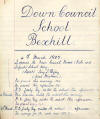 |
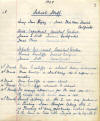 |
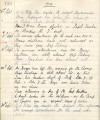 |
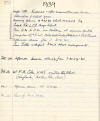 |
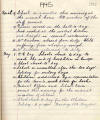 |
(This history has been compiled from local history, ex-pupils memories and references in the School Logs, some of which are very brief, if you have any further information I would love to hear from you; king(at)kingoffa(dot)e-sussex(dot)sch(dot)uk; our thanks also to ex-pupils and their families who have supplied photos.)
